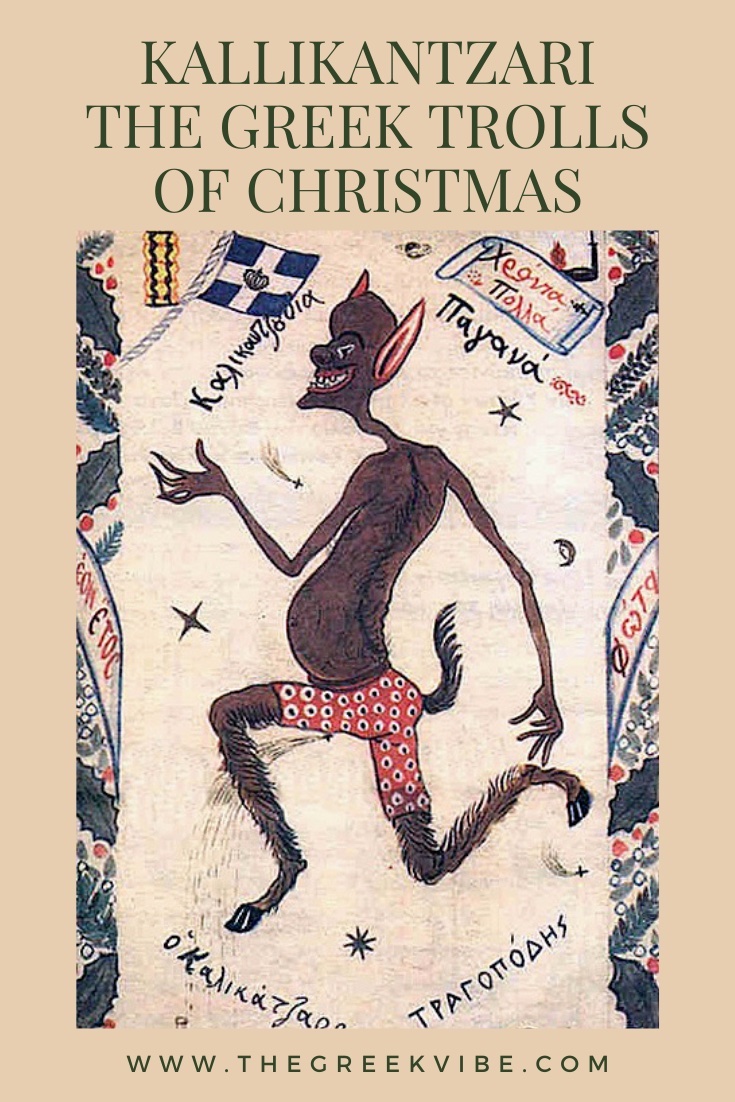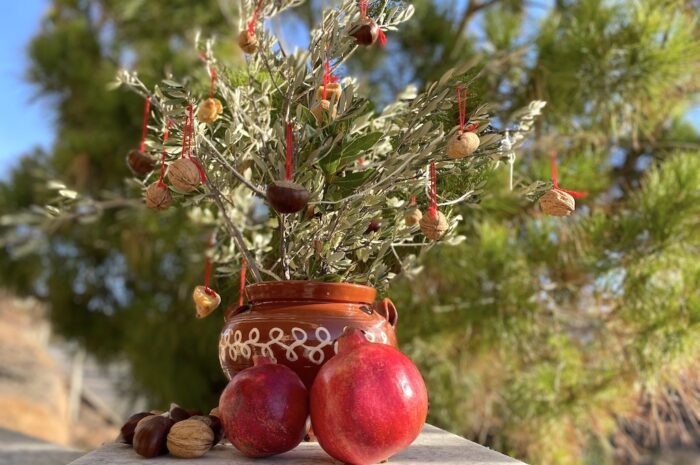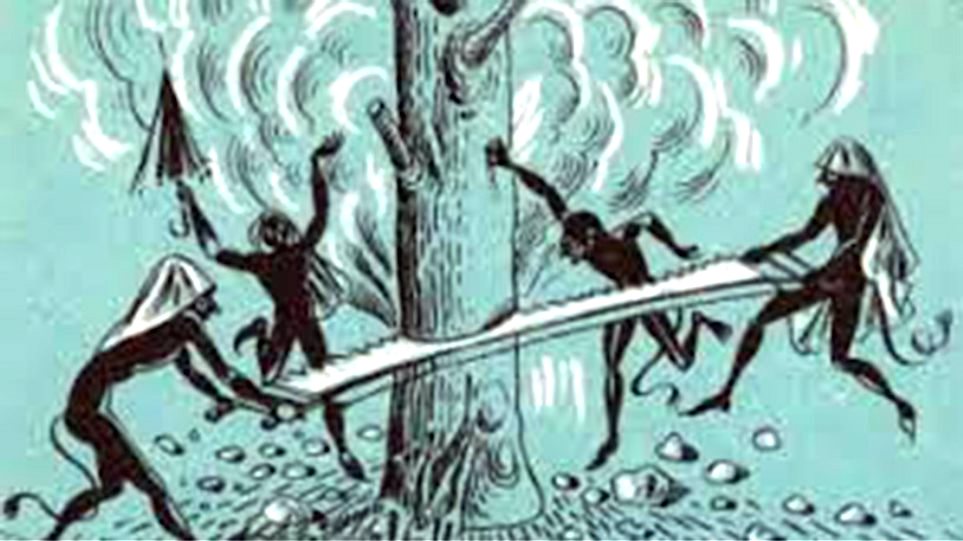
I first heard about the kallikantzari when I was about 7. These ugly, nasty creatures that came to the earth every Christmas in Greece and wreaked havoc until January 6th came to life thanks to my mother’s vivid storytelling. And all this in windy, snowy and cold Chicago.
In the kitchen – where most Greek families spend their days – while helping my mother make traditional Greek holiday treats melomakarona or kourabiedes, she would lower her voice and speak of the kallikantzari, who would be chopping away all year round at the tree of life in hopes of destroying life on earth, and then emerge from the darkness to frighten and pick on people for 12 whole days.
The Greek tradition for Christmas and New Year’s has nothing to do with the playful, jolly elves I saw on American television. Instead, these beings were playful but in a bad way and very eager to terrify humans. For 12 days every night, I would be ultra-vigilant, alert to all sorts of creaks and cracks making sure none of these trolls had made their way into the house roaming in the kitchen and destroying all the goodies my mother had made.
►Vassilopita: A Greek New Year’s Cake Bearing Gifts
The Kallikantzari & Their Antics

The kallitakantari or “kantziolia”, as my mother called them, were night critters, lanky red-eyed beings with long nails and black tails, like gnomes very mischievous and agile, who would jump from one rooftop to the next, and sneak their way into homes through the chimney or keyholes, or into backyards, and trash everything in sight or steal food and children, especially those born on Christmas Day .
That’s why, my mother explains, it was very important to make sure everything was covered tightly with a lid. One of their favorite pranks was to scatter flour, which was to be found everywhere due to the holiday baking. You could hear their shrill laugh!
I think writer Clement A. Miles sums it up accurately:
“Destruction and waste, greed and lust mark their course.”
According to lore, roaming at night during this time is ill-advised: you just might run into one of these obnoxious creatures who will make sure to give you a fright.
►Karavaki: The Greek Christmas Boat of Hope
Kallikatzari are small and dark-skinned and most have some kind of flaw. They limp, or have a lisp, or goat feet or monkey arms. Though they live on snakes, worms and frogs, they love sugar and that’s why many housewives would leave some sweets at different spots in the house to cajole them into being nice.
And indeed life on earth for 12 days for the kallikantzari is all about wanton mischief… until the rooster crows – that is – and the sun shines its way into the sky.
Much like Dracula and all of the world’s dark demons and vampires, the kallikantzari hate the sun. They also abhor fire, the cross and Holy Water, and have a very short attention span… so as much as they hope to do harm, they never succeed.
💡Don’t know what to get everyone for Christmas? How about gifts inspired by Greece?
Keeping the Kallikantzari at Bay
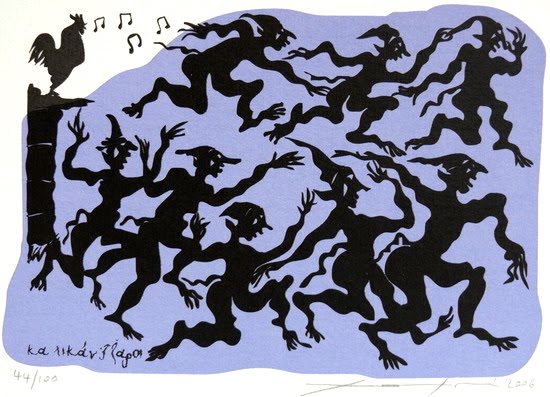
A large part of Greek Christmas and New Year’s holiday traditions was in the past dedicated to keeping these goblins out of the house, away from the children and away from the food.

To ward off these tedious trolls, families would burn a large thorny piece of wood – known in Greek as the “Christoxylo” (wood of Christ), “Dodecameritis” (12-day wood) or the “Skakantzalos”. The fireplace was kept alight throughout the 12-day period to make sure they didn’t make their way down the chimney.
My father told me that my grandmother – Yiayia Marigo – shrewder than most, would also place a massive pot (“tsoukali”) over the fire with a barley concoction. The smell would attract the creatures who would then fall into the boiling pot!
Both my mother and father vividly remember that the tales of the kallikantzari were very true and very frightening. Parents would often “employ” their arrival to scare children into obedience. Thankfully, old ways are now a thing of the past.
Daily the ashes from the fireplace would be collected and scattered outside, around the house, in the stables, the garden, the olive groves to drive away all evil. Most houses also had the sign of a cross “burnt” into the entrance believed to hinder the little devils.
💡Looking for inspired gift ideas? Make sure to check out this handpicked selection perfect for Greece fans.
Other ways of keeping the kallikantzari distracted and out of trouble included burning an old shoe in the fireplace, hanging a pig jaw behind their front door, burning “livani” (incense), or hanging cured meats inside the chimney. The best, was leaving a sieve around. With a short attention span and not too bright, the kallikantzari gather and try to count the holes… by the time they’re done, the sun is out and off they go until nightfall.
►Epiphany: When Greeks Bless the Waters to Mark a New Start
Epiphany Day: Away with the Kallikantzari

Every year, on January 6, Greeks celebrate the Blessing of the Waters, known as Epiphany Day or “Theophania“, which means “God Emerging in the Light“.
The brightest day of the year, Epiphany Day brings the holiday season to a close, sending a message of spiritual rejuvenation and inner cleansing. This is also the last day the kallikantzari have here on earth. The Christoxylo has burned away, the fragrance of incense fills the air, and in the past, the priest of the “enoria” (neighborhood or village church) would go through each home blessing with a batch of basil dipped in Holy Water.
Intimidated by the light and love, Greece’s Christmas trolls are driven back into the hollows of the earth to axe away at the tree of life, which has in the 12 days grown back.
►What Do Greeks Do on New Year’s
Kallikantzari & The Message Today
The truth is our naughty friends have little time here on earth to do their dirty work, or is it dirty after all? The kallikantzari emerge from their dingy dens and go on rampage for six days in the old year and six in the new. This 12-day period between Christmas and Epiphany is also the darkest period of the year and for many of us, the most challenging as we are faced with leaving the comfort of the past behind (and all its mistakes) and stepping into the new and unknown.
I strongly believe that often the answers we need today can be found in our very wise folk traditions. The messages for me are clear: the kallikantazari – which many believe date back to ancient Greek Dionysian practices – come once a year to (forcefully) remind us that when we are off guard, negative energy always has a way of sneaking in and throwing us off balance, pushing us away from inner harmony. As in the tales of the kallikantazari … Our soul needs tidying up, care, love and faith in kindness and love.
And lastly, and most importantly for me, the chaos created by the kallikantzari, these shadowy, human-like creatures, is short-lived, as are all moments of difficulty and darkness. As the Sufi poets wisely said: “This too shall pass”.
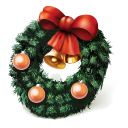
Merry Christmas, everyone and Happy New Year!
🎶I end today’s post with a musical tale inspired by the kallikantzari by the Katsimichas brothers – Haris and Panos – recorded here in 1979 for Greek public broadcaster and narrated by screenwriter and storyteller Nikos Pilavios about a smile-less city that comes to life thanks to some resourceful kallikantzari.
Enjoy!
❤️ Follow The Greek Vibe on TikTok too!
Enjoy this Post? Share and Pin it!
